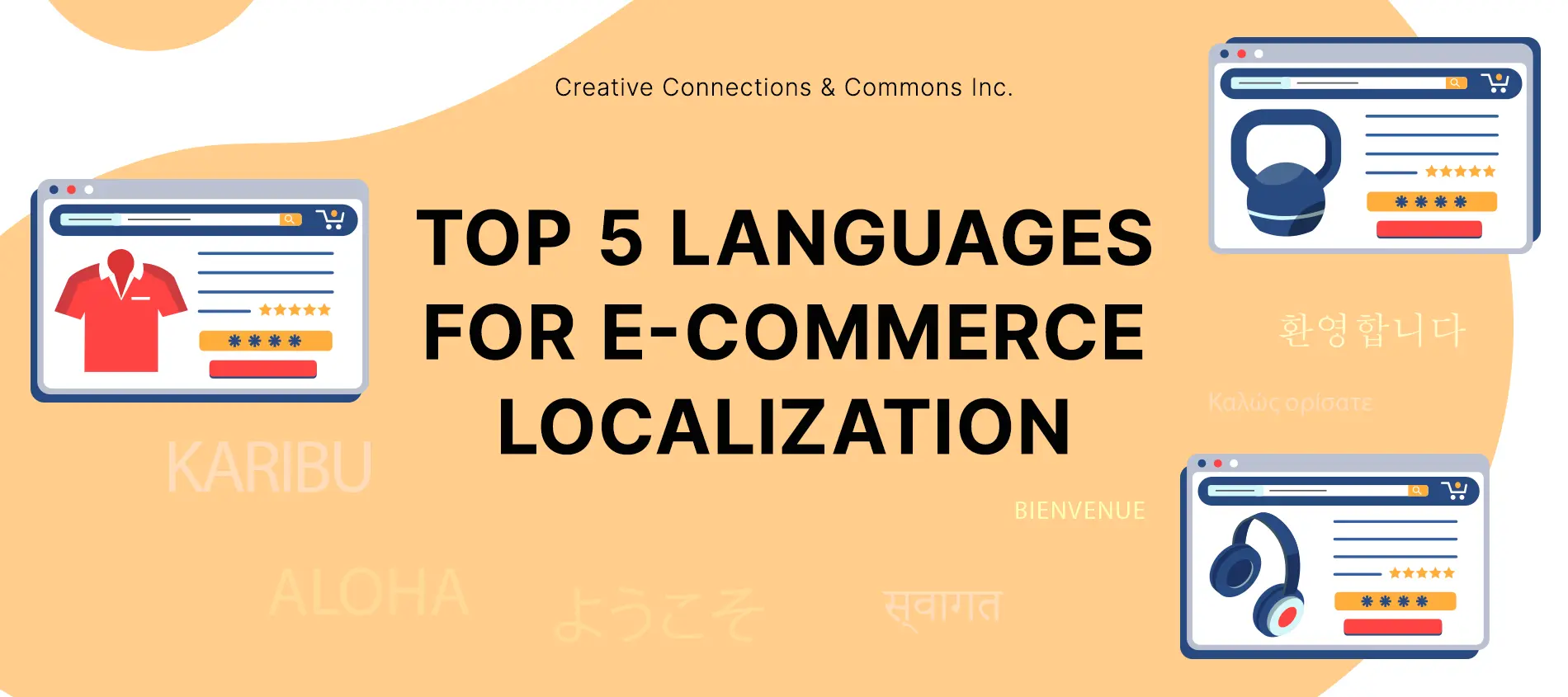Key takeaways
- Identifying the top languages for e-commerce localization helps you reach a wider global audience, boosting your market share.
- Implementing language targeting for e-commerce enhances e-commerce strategies by improving your site’s accessibility to non-English speaking customers.
- Effective language strategies for online sales can improve customer experience.
- Professional website localization services, like those offered by CCC, can enhance your website’s effectiveness and global reach.
Table of contents
- Why E-commerce Localization Matters?
- Top 5 Languages for E-commerce Localization
- How To Localize Your E-commerce Business
Global retail e-commerce sales continue to grow. In 2023, Statista reported an estimated 5.8 trillion U.S. dollars in global retail e-commerce sales. Moreover, experts project this figure to grow by 39%, expecting it to surpass eight trillion dollars by 2027. Businesses looking to take part in this growth may do well to identify languages for e-commerce localization. This powerful tool helps businesses reach new customers and expand globally. By targeting the right languages, you can significantly improve your e-commerce efforts.
Why E-commerce Localization Matters?
E-commerce localization means adapting your content for different markets with unique cultural and linguistic preferences. It is a process that includes specialized translation in which language experts prioritize cultural nuances over direct language conversion. Furthermore, it considers local customs when modifying design elements and adjusting marketing strategies.
Having a well-crafted e-commerce localization strategy is vital for any business looking to break into international customer bases. By localizing, more audiences can relate to your website. Audience diversification leads to increased engagement, higher conversion rates, and enhanced brand loyalty.
Additionally, it helps you appeal to customers who prefer interacting with websites in their native language. Ultimately, it drives global business growth. Here’s a closer look at the benefits of e-commerce localization services:
Expanded Reach
When localizing e-commerce sites, you essentially target non-English speaking customers. Based on a 2020 survey, 73% of global consumers who shopped online preferred product reviews in their native languages.
By catering to these preferences, you would expand your market reach and boost sales in the process. Moreover, this approach opens up opportunities in previously inaccessible markets. Accordingly, you tap into a pool of potential customers. With language targeting for e-commerce, you create a more inclusive shopping experience that attracts a broader audience.
Improved Customer Experience
Customers who can navigate and understand your site in their language enjoy a positive shopping experience. Consequently, shoppers feel more comfortable and valued, leading to more customer satisfaction and loyalty.
With professional website localization services, you reduce language barriers. Thus, you decrease the chances of miscommunication and errors. Communication issues often frustrate customers, leading them to abandon their carts. Offering a localized experience makes customers more likely to complete their purchases and return for future transactions.
Better SEO Performance
Localized content significantly improves your site’s search engine ranking in different regions. By using keywords in the local language, you enhance your visibility and attract more organic traffic.
This strategy helps you appear in local search results. Thus, potential customers can easily find your site. Effective language strategies for online sales include optimizing product descriptions, meta tags, and other content for local search engines. These drive more targeted traffic to your site and boost overall performance.
Top 5 Languages for E-commerce Localization
Chinese
China has the world’s largest e-commerce market. Millions of online shoppers actively participate in online retail through platforms like Alibaba and JD.com. Thus, localizing in Chinese makes your products and services accessible to this massive market. Furthermore, you can boost your reach by using popular local payment methods like Alipay and WeChat Pay.
Pro-tip: China’s lucrative market has multiple localization opportunities for business growth. One popular strategy is adapting to local shopping festivals such as Singles’ Day. Focusing your Chinese marketing efforts to this cultural avenue enhances your presence by targeting local customs.
To maximize your global potential, consider optimizing your strategies to these top five for your e-commerce localization strategy. This approach ensures you effectively target the most impactful markets.
Spanish
E-commerce localization services also offer Spanish localization strategies. This market offers high sales volumes since over 500-600 million people speak Spanish across Spain, Latin America, and the US. You can tap into a vast and rapidly growing e-commerce market by tailoring your content to fit regional variations. Engaging with local influencers can also boost brand credibility and help you connect with a broader audience.
German
Germany is the second-largest e-commerce market, with the UK at the top. Accordingly, you may want to include German among your languages for e-commerce localization. By localizing your site in German, you can increase your presence in the European market and reach a large customer base.
Note: It’s crucial to prioritize high-quality translations to ensure clarity and professionalism. Additionally, providing local customer support to address queries and concerns effectively can significantly enhance customer trust and loyalty.
French
French offers access to diverse and profitable markets in numerous countries across Europe and Africa. Canada also has a French-speaking market that you could tap into. French localization allows entry into these various regions, each with significant purchasing power. Understanding local customs and the unique market dynamics can help you adapt your content to cultural nuances.
Japanese
Localizing your e-commerce efforts for Japanese markets gives you access to Japan’s high-spending online consumer. Japanese consumers tend to prioritize quality and convenience when it comes to e-commerce. To meet these high expectations, it’s using respectful and appropriate business language is vital. Keeping up with the local trends, preferences, and shopping behaviors can also enhance your site’s appeal. Furthermore, ensure a mobile-friendly website, as many Japanese consumers prefer shopping via mobile devices.
By focusing on these top languages, you can implement an effective e-commerce localization strategy. Successful execution would expand your reach and enhance your market presence globally. Our Business Localization services can provide the expertise you need to navigate these markets successfully. With professional website localization services, you can ensure your e-commerce site resonates with your target audience, driving engagement and sales.
How To Localize Your E-commerce Business
Professionals like CCC follow several crucial steps in successfully localizing e-commerce sites. Understanding the professional method may provide insights into the ways you can improve your global reach through expert strategies. Consider these strategies:
- Research your target market: Understanding the cultural and linguistic nuances of your target market is essential. This research helps you create relevant content. It also gives ideas on tailoring marketing strategies that resonate with local audiences. By identifying key cultural elements and language preferences, you ensure your approach aligns with local expectations.
- Translate and localize content: Work with professional translation services to ensure accurate and culturally appropriate translations. CCC’s e-commerce localization services can provide the accuracy you need. Accurate translations capture the essence of your content, making it relatable to the local audience.
- Adapt your website design: Adapting your website design to accommodate different languages involves considering varying text lengths and reading directions. Put simply, you must ensure your website layout is flexible for all your target languages. For instance, languages like Arabic read from right to left. This language will require specific design adjustments to maintain a seamless user experience.
- Offer local payment options: Integrate local payment methods to make the checkout process smoother for international customers. This step enhances the user experience and builds trust with customers who may be unfamiliar with international payment systems.
- Provide local customer support: Offering customer support in the local language can enhance trust and satisfaction. This support can include multilingual customer service representatives, localized FAQs, and support documentation tailored to local needs.
By focusing on languages for e-commerce localization, you can effectively expand your business globally. With our professional website localization services, we can assist you in every step of the process. Let us ensure your site resonates with diverse audiences and drives international success. Contact us.









